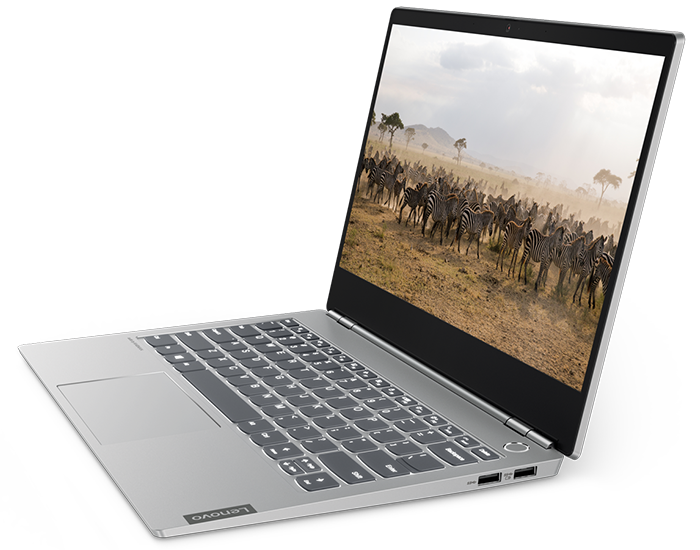Introduction
When picking a workplace laptop it is easy to come to the conclusion that you can't go wrong with a ThinkPad. Lenovo's business-orientated brand is synonymous with robust build quality, recognisable aesthetics and global support, and continues to serve as an obvious choice for companies familiar with the ThinkPad package.
When something works so well, changing the formula can be quite a challenge. Lenovo has, in recent years, attempted ThinkPads in different colours, and once made the ill-advised decision to remove the red nub synonymous with ThinkPad keyboards. Such alterations didn't go down well with the ThinkPad faithful, but lessons have been learnt, and Lenovo has since adopted a two-pronged strategy.
On the one hand, ThinkPads will continue to be ThinkPads, and on the other hand, we now have an entirely new line of ThinkBooks that claim to marry business-friendly services with an outward aesthetic 'designed for generation next.' Lenovo's rationale is that "nearly 60 percent of what’s being dubbed the “new workforce” grew up working, creating and communicating online with stylish devices that make a statement." Apparently, the cool kids don't want to be seen with jet-black ThinkPads.
A Trendier ThinkPad?
At first glance, our ThinkBook 13s review unit seems a worthwhile alternative. It is undoubtedly more modern in appearance, with a sleek silver aluminium chassis sporting smooth lines and, of course, no sign of a red trackpoint nub. I like it, but I've got to be honest, I don't love it, and that's because I'm quite fond of the traditional ThinkPad. There's a uniqueness about Lenovo's flagship line that is missing from the ThinkBook; the 13s is a perfectly stylish machine, yet it lacks that feeling of exclusivity.
This is effectively a ThinkPad Lite, and as such there are a few features missing from the spec sheet. Don't expect the same level of military-grade ruggedness you get from a ThinkPad - though Lenovo does boast anti-spill protection for up to 60cc of water - and you may find overall build quality to be just a tad lower. Whereas ThinkPads tend to be noticeably rigid throughout, the ThinkBook 13s has a reassuringly solid outer frame but a little more flex in the keyboard tray than we'd like.
There's also no option for a touchscreen, the webcam doesn't support Windows Hello, and though there is an option to buy into Lenovo's more expansive Think Service support plans, the default warranty is a paltry one year. ThinkPads are the more comprehensive choice, yet if the aforementioned features aren't paramount, the ThinkBook 13s does start at a far more tempting £650 price tag.
For the money you get an Intel Core i5 processor with onboard UHD 620 graphics, a 13.3in 1080p IPS display, 8GB of DDR4 memory and a 256GB M.2 SSD. Safe choices all round, plus the next model up offers a Core i7 chip, double the amount of memory and storage, while still keeping pricing below the £1,000 mark. Do note that while our review unit packs an 8th Gen Core i5-8265U, Lenovo's latest stock includes a 10th Gen Core i5-10210U as standard.
IdeaPad Similarities
ThinkBook 13s has merit for small businesses wanting to upgrade the workforce's computing arsenal, yet in use it quickly becomes apparent that the latest addition to the Think product line has more in common with the everyday IdeaPad. A significantly large chin below the display detracts from the overall aesthetic, the downward-firing speakers lose some composure at higher volumes, and if you're a fan of ThinkPad keyboards, you'll notice that the ThinkBook solution is a step down from Lenovo's premier product.
That isn't to say the keyboard is bad - the backlight is decent and the layout feels roomy - but the shorter travel distance is more in keeping with an IdeaPad, and you don't get the contoured keycaps present on products higher-up the Think product stack. Still, the keyboard is pleasant to type on, the large Precision trackpad is responsive, and seeing as all business laptops ought to have some form of biometric security, the power button doubles as a reasonably quick fingerprint reader.
Overall dimensions of 308mm x 216mm x 15.9mm and a weight of 1.3kg are in line with our expectations of a device of this size, and Lenovo keeps both WiFi and Bluetooth up to date courtesy of an Intel Wireless-AC 9560 adapter. Physical connectivity options include a pair of USB 3.1 Gen 1 Type-A on the laptop's right side, while over on the left there's an audio jack, USB 3.1 Gen 2 Type-C, HDMI 1.4b and a proprietary connector for the 65W power adapter. There's neither an SD card slot nor Thunderbolt support, but arguably the biggest bugbear is an inability to charge via USB-C.
The ThinkBook ultimately feels closer to an IdeaPad than a ThinkPad, yet there are a handful of recognisable value-adds. These include the ThinkShutter privacy slider on the front-facing 720p webcam, the ability to extend the display hinge a full 180º, and a Rapid Charge 45Wh battery that can top-up to 80 per cent capacity in just one hour.












